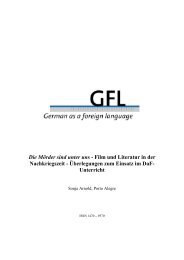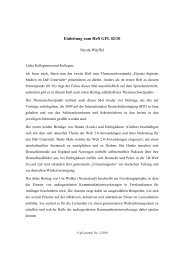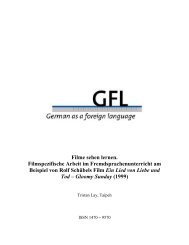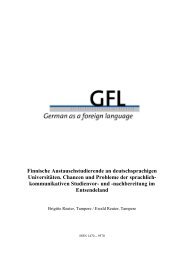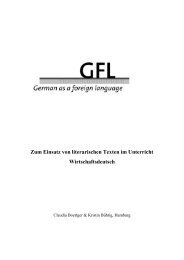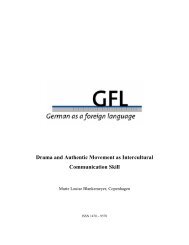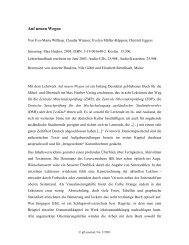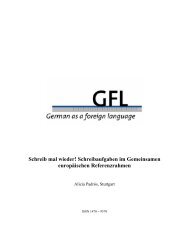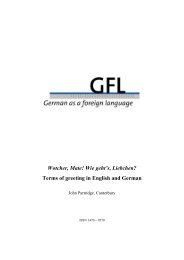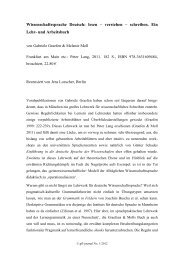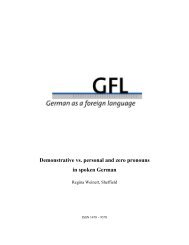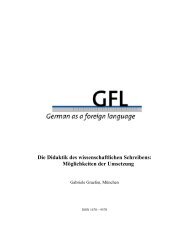Der Schulerwerb von Deutsch als Fremdsprache - GFL-Journal
Der Schulerwerb von Deutsch als Fremdsprache - GFL-Journal
Der Schulerwerb von Deutsch als Fremdsprache - GFL-Journal
You also want an ePaper? Increase the reach of your titles
YUMPU automatically turns print PDFs into web optimized ePapers that Google loves.
<strong>Der</strong> <strong>Schulerwerb</strong> <strong>von</strong> <strong>Deutsch</strong> <strong>als</strong> <strong>Fremdsprache</strong><br />
135<br />
The reviewer thus feels that several aspects of what the author merely calls "data entry" would<br />
have deserved more explicit reflection. Otherwise, the critical reader might experience<br />
difficulty in following specific coding decisions such as, for example, the coding of an<br />
omission of the subject in the following learner utterance "ich denke [...], dass [...] ist nicht<br />
schwierig [...], einen Beschluss zu fassen [...]" (Terrasi-Haufe 2004:20) or the decision to code<br />
norm-deviant realizations such as "auf ein genetisch Tomaten" (Terrasi-Haufe 2004:25) as<br />
masculine (thereby ignoring the option of neuter) on the basis that the first language, Italian,<br />
does not have a neuter gender. Finally, when Terrasi-Haufe develops a coding system for<br />
linguistic actions, similar concerns arise in that she does not spell out her underlying<br />
theoretical assumptions. For example, she appears to conceptualize her pragmatic analysis as<br />
an additional level added on to her lexical and morpho-syntactical research, even though this<br />
approach is not easily reconciled with the functional-pragmatic framework of Ehlich or<br />
Redder whose work she relies on.<br />
This leads us to a third point worthy of future discussion. A more explicit interpretation of the<br />
empirical findings in terms of theory development could prove of great interest to researchers<br />
in the field of second language acquisition. Terrasi-Haufe does establish some explicit<br />
connections of her rich description to other studies. However, it is generally not her priority to<br />
interpret her findings with respect to underlying processes or current theories of second<br />
language acquisition such as, for example, Pienemann’s (1998) processability theory,<br />
although this particular theory is highly relevant to her discussion of sequencing instruction<br />
according to acquisitional stages (see Terrasi-Haufe 2004:197). Readers who do not go along<br />
with her implicit assumption that the target language is the only option to use as a basis for<br />
the analysis of the data might remain curious about her explicit concept of learner language.<br />
In further discussion, the reviewer would welcome attempts to spell out more clearly such<br />
theoretical concepts underlying the coding categories and the discussions and to position the<br />
rich empirical description within the wider context of second language acquisition theory (e.g.<br />
Doughty & Long 2003) more explicitly. It goes without saying that all bibliographical<br />
references of such theoretical discussion need to be complete as well as correct, which<br />
unfortunately is not the case.<br />
Conclusion<br />
Terrasi-Haufe’s work is a valuable contribution to empirical research on <strong>GFL</strong> acquisition. It is<br />
based on a well-composed corpus, relies on extensive coding of empirical data, and uses<br />
© gfl-journal, No. 2/2005



